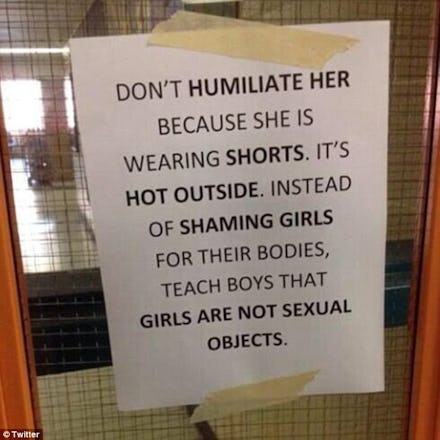What Happened to This Student for Wearing Shorts at School is Body Shaming at its Worst

Another week, another girl being shamed by adults at her school for the crime of having a body.
Fifteen-year-old Lindsey Stocker is protesting her school's dress code after being told by officials that her shorts were too short and that she needed to change her clothes. Stocker felt "attacked" and "humiliated" after being called out in a classroom full of other students.
These types of incidents seem to be increasingly commonplace (or at least, they are being reported more), and Stocker, an 11th grader at Beaconsfield High School in Quebec, is fighting back. Inspired by a message she saw on Tumblr, the teen put up posters around school calling on officials to stop shaming students' bodies.
Image Credit: Twitter via Daily Mail
Stocker told CBC News that two school officials walked into her class on a warm day in late May and forced all of the students to stand with their arms by their sides. Any student whose shorts or skirts did not reach their fingertips was considered to be in violation of the dress code.
"In front of all my peers and my teacher they said I had to change," Stocker told the National Post. "And when I said no they said I was making a bad choice. They kept shaking their heads. In front of everybody."
Stocker also claimed that the dress code unfairly targets female students, saying, "They don't really care what guys wear."
The posters were promptly removed, but their empowering message spread widely thanks to social media. As news of the protest grew, other girls also wore shorts to Beaconsfield as a show of solidarity. Fellow student Lauren Paquay told the CBC, "People are being judged for the way they dress, they have to change because boys look at them. The boys should be the ones who have to learn to treat women better and look at them in a different light."
She's right. As just one incident in a long list of girls being asked to change their outfits for being too revealing or provocative, Stocker's experience reminds us how distressingly common this regulation of women's bodies has become both in Canada and the U.S. Just last week, for example, a Utah high school Photoshopped dozens of girls' (and only girls') yearbook photos to make them less revealing.
Typically done in an effort to prevent "distracting" male classmates, telling girls what they can and cannot wear sends the message that they are responsible for boys' thoughts and actions and that their natural bodies are shameful things to be hidden.
This is especially troublesome when it comes from adults in influential positions during kids' impressionable adolescence, meaning school administrators really have to start listening and sending the right messages. It's simple: Grant girls bodily autonomy and respect boys enough to handle themselves around girls in shorts.
The issue for one school board member boils down to rules, however, not beliefs.
"The rules are there to help the children learn and prepare them for their future work places," Susanne Stein Day told CBC. "High school is a job for them, they are there to learn to function in society, so it's important that the rules be followed."
Rules may be rules, but that doesn't make them right. Stocker said, "I was in violation for showing my legs. And that, point blank, is a problem for me."
The school could have viewed this incident as a chance to revisit dated dress code regulations that police students' bodies. Instead, Stocker has been suspended.